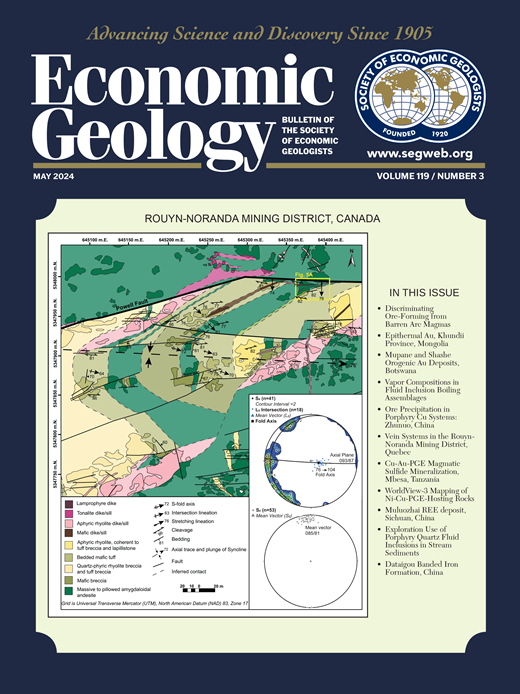The Age and Origin of the Ruwai Polymetallic Skarn Deposit, Indonesia: Evidence of Cretaceous Mineralization in the Central Borneo Metallogenic Belt
IF 4.9
1区 地球科学
Q1 GEOCHEMISTRY & GEOPHYSICS
引用次数: 0
Abstract
The Ruwai skarn deposit is the largest polymetallic skarn deposit in Borneo and is located in the Schwaner Mountains. The skarns and massive orebodies are hosted in marble of the Jurassic Ketapang Complex, which was intruded by Cretaceous Sukadana granitoids. The prograde-stage garnet and retrograde-stage titanite yielded U-Pb ages of 97.0 ± 1.8 to 94.2 ± 10.3 Ma and 96.0 ± 2.9 to 95.0 ± 2.0 Ma, respectively. These ages are similar to Re-Os ages obtained on sulfides (96.0 ± 2.3 Ma) and magnetite (99.3 ± 3.6 Ma). The U-Pb zircon ages reveal that magmatism at Ruwai occurred in three phases, including the Early Cretaceous (ca. 145.7 and 106.7–105.7 Ma; andesite-dacite), Late Cretaceous (ca. 99.7–97.1 Ma; diorite-granodiorite), and late Miocene (ca. 10.94–9.51 Ma; diorite-dolerite). Based on geochemical and stable isotopic data (C-O-S) the Ruwai skarn ores are interpreted to have formed from oxidized fluids at ca. 160 to 670°C. The ore-forming fluids and metals were mostly magmatic in origin but with significant crustal input. Ruwai skarn mineralization occurred in the Late Cretaceous, associated with Paleo-Pacific subduction beneath Sundaland after the Southwest Borneo accretion. Ruwai is the first occurrence of Cretaceous mineralization recognized in the Central Borneo metallogenic belt.印度尼西亚汝外多金属矽卡岩矿床的时代与成因:婆罗洲中部成矿带白垩系成矿作用的证据
如外矽卡岩矿床是婆罗洲最大的多金属矽卡岩矿床,位于施瓦纳山脉。矽卡岩和块状矿体赋存于侏罗纪卡塔邦杂岩的大理岩中,该杂岩受白垩纪苏卡达纳花岗岩体侵入。顺行期石榴石和逆行期钛矿的U-Pb年龄分别为97.0±1.8 ~ 94.2±10.3 Ma和96.0±2.9 ~ 95.0±2.0 Ma。这些年龄与硫化物(96.0±2.3 Ma)和磁铁矿(99.3±3.6 Ma)的Re-Os年龄相似。U-Pb锆石年龄表明,汝外岩浆活动发生在早白垩世(约145.7和106.7 ~ 105.7 Ma)三个阶段;安山岩-英安岩),晚白垩世(约99.7-97.1 Ma);闪长岩-花岗闪长岩)和晚中新世(约10.94-9.51 Ma);diorite-dolerite)。根据地球化学和稳定同位素(C- o - s)资料,认为如外矽卡岩矿石形成于约160 ~ 670℃的氧化流体中。成矿流体和成矿金属以岩浆流体为主,地壳输入量较大。如外矽卡岩成矿发生于晚白垩世,与西南婆罗洲增生后巽他陆下古太平洋俯冲有关。如外是婆罗洲中部成矿带首次发现的白垩系矿化产状。
本文章由计算机程序翻译,如有差异,请以英文原文为准。
求助全文
约1分钟内获得全文
求助全文
来源期刊

Economic Geology
地学-地球化学与地球物理
CiteScore
10.00
自引率
6.90%
发文量
120
审稿时长
6 months
期刊介绍:
The journal, now published semi-quarterly, was first published in 1905 by the Economic Geology Publishing Company (PUBCO), a not-for-profit company established for the purpose of publishing a periodical devoted to economic geology. On the founding of SEG in 1920, a cooperative arrangement between PUBCO and SEG made the journal the official organ of the Society, and PUBCO agreed to carry the Society''s name on the front cover under the heading "Bulletin of the Society of Economic Geologists". PUBCO and SEG continued to operate as cooperating but separate entities until 2001, when the Board of Directors of PUBCO and the Council of SEG, by unanimous consent, approved a formal agreement of merger. The former activities of the PUBCO Board of Directors are now carried out by a Publications Board, a new self-governing unit within SEG.
 求助内容:
求助内容: 应助结果提醒方式:
应助结果提醒方式:


